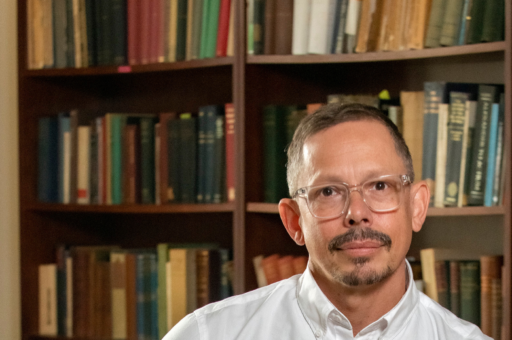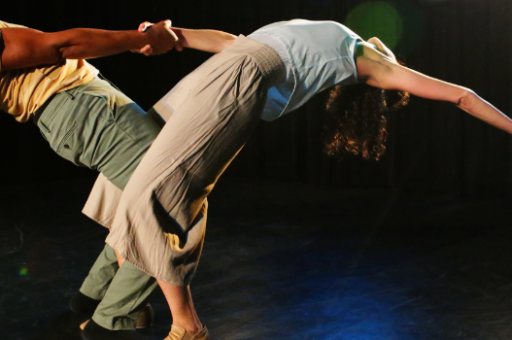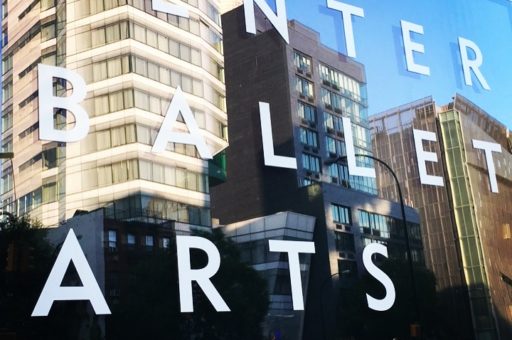Christopher Williams (CBA ’18) is a choreographer, dancer, and puppeteer who has created over 30 movement-based works in New York City and abroad since 1999. His work has been presented internationally in France, England, Italy, Spain, Holland, Colombia, and Russia, nationally in Los Angeles, Philadelphia, Interlochen, and Kalamazoo, as well as in local venues including City Center, Lincoln Center, Dance Theater Workshop, Danspace Project, P.S. 122, the 92nd Street Y, and La Mama. His collaborators have included directors Peter Sellars and Michel Fau, conductor Raphaël Pichon of Ensemble Pygmalion, members of the Anonymous 4, as well as critically acclaimed composer Gregory Spears and visual designer Andrew Jordan. His commissioners have included the Opéra National de Bordeaux/Opéra Royal du Château de Versailles, English National Opera/Teatro Real/Perm Opera & Ballet Theater, Interlochen Center for the Arts, NYU’s Tisch School of the Arts, Princeton University, the Harkness Dance Center, DTW, Danspace Project, Wanderlust Dance Project, and HERE Arts Center’s Dream Music Puppetry Program. His awards include a New York Dance and Performance “Bessie” Award (2005), fellowships from The Foundation for Contemporary Arts, the New York Foundation for the Arts, and the Bogliasco Foundation, as well as residencies via the Robert Raushenberg Foundation at Robert Wilson’s Watermill Center, the Tyrone Guthrie Center, Kaatsbaan International Dance Center, Harkness Dance Center, Movement Research, Mt. Tremper Arts, Joyce SoHo, Djerassi, Yaddo, and The Yard.
For more about Williams’ CBA Fellowship, visit his fellow page.
Please briefly describe your CBA Fellowship project.
A longstanding dream of mine has been to re-imagine some of the great mythic-themed ballets originally conceived for the Ballets Russes in my own choreographic idiom. As writing a grand opera of mythic proportions is to certain composers, re-imagining a ballet of this ilk is to me as a choreographer. Thanks to my Spring 2018 Resident Fellowship at The Center for Ballet and the Arts, I have begun researching, creating, and refining choreographic material for an original, full-length contemporary ballet entitled Narcissus set to Nikolai Tcherepnin’s ballet score, Narcisse et Echo, scènes mythologiques pour orchestre, composed in 1911 for Diaghilev’s famed company. The new work for seventeen dancers, featuring costumes by longtime visual design collaborator Andrew Jordan and sets by David R. Harper, will reappropriate themes of the eponymous Greek myth on which it is based to re-envision the original ballet through a contemporary queer lens.
How did you conceive of the characters and concepts in Narcissus? What were your primary inspirations?
For the most part, the dramatis personae in my Narcissus are drawn directly from the titles for various movements of Tcherepnin’s ballet score (i.e. Entrée des Boétiens et les Boétiennes, Danse de la Bacchante, and Danse de Narcisse). I imagine the Boeotians as an ancient Greek tribe to which Narcissus belongs, and the Bacchantes as three priestesses/shamanesses that lead them. The cast for these human roles will ideally include a group of seasoned contemporary dancers of differing ages and ethnicities with whom I have always wanted to work. Drawn from my own imagination sparked by a handful of Léon Bakst’s design drawings for the original production (curiously labeled divinité inférieur, demi-divinité, and divinité mineur), as well as depictions of nymphs, satyrs, and silens in classical Greek vase painting, the supernatural characters in the work include Echo and a tribe of oreads (or mountain nymphs) to which she belongs. The concept of Echo being an intersex character (performed by a cisgender gay male) among the oreads (performed by an all gay male corps de ballet) occurred to me as I was considering various dancers for the roles and appealed to me as an intriguing twist on the original myth that could allow it to further evolve in a contemporary queer cultural context. One of the new ballet’s major dramatic conceits, that Echo is tragically scorned for her gender duality by members of her own tribe (an occurrence that is later echoed when Narcissus abandons her for his own image), is inspired largely by the struggles of transgender and queer citizens I have witnessed in our current political climate.

Describe your choreographic process. Did your conception of this piece evolve as you began working with dancers at CBA?
The choreographic process for my most recent works has been to create steps alone on my own body in the studio in direct response to musical scores. I have then subsequently taught this pre-crafted material to dancers and arranged it in space to set the choreography for each new work. In the case of Narcissus, I had had the opportunity to workshop phrases of movement set to the first two sections of Tcherepnin’s score with dancers from 10 Hairy Legs, so I was already plied with a structure for how they would be realized choreographically before I arrived at The Center. Additionally, just prior to my arrival, I had completed a fellowship at the Bogliasco Foundation in Italy where I had created steps for two solo sections for the character Echo. I was thus ready to spend my first two weeks at The Center diving intensively into the material with a new corps of five dancers with whom I had never worked (with the exception of one who had been a part of my earlier workshop) and with New York City Ballet principal dancer Russell Janzen in the role of Echo. Observing how the roles I conceived for individual dancers evolved significantly in just the two weeks I’d been working in the CBA studio before my seminar showing was a particularly informative and rewarding moment of the process. I noticed how the movement material was almost instantly imbued with deeper meaning when it was transferred to other bodies portraying specific characters in the context of the larger work. To my delight, nuances that Russell brought with his classical dance training in contrast to my contemporary dance vocabulary, for example, opened up a kind of dual kinetic expression of the intersex character Echo’s physicality as a being embodying two genders.
What is the significance of your music selection for Narcissus?
Interestingly, when Diaghilev found that Ravel would not have time to compose the music to enable Daphnis et Chloé to be produced during the next Ballets Russes season in Paris, he hastily commissioned Tcherepnin to compose the music for Narcisse et Echo in the “Grecian” style to a scenario by Léon Bakst after Ovid’s Metamorphoses. The new ballet’s premiere took place on April 26th, 1911 in Monte Carlo, with the composer conducting. Although there are strong similarities between the two scores not only in the performing forces (which include large orchestra and choir), but also in the musical approach to the rather similar narratives, it is not known whether Tcherepnin had any opportunity to see the score of Daphnis et Chloé in advance of rehearsals. In light of this, I’ve wondered whether Ravel might have been influenced by Tcherepnin’s score, rather than the other way around. Upon hearing it for the first time, I discovered a great love for the score’s fantastical sound featuring harps, celesta, xylophone, piano, glockenspiel, and wordless chorus to achieve remarkable atmospheric effects that palpably transport the listener to another world. I could not help but immediately begin envisioning how that other world could be made manifest choreographically. Regardless of the fact that Tcherepnin’s score was eclipsed by more famous pieces by Ravel and Debussy and thereby plunged into obscurity, I consider the ballet to be on par with the great musical impressionist works of its time.

Please talk about your costume design process. What were some of the key choices you made? How did these choices influence the piece?
I have worked for nearly a decade with visual design collaborator Andrew Jordan on original choreographic works in which the costumes play as important a role as do the music and choreography. Our process begins with me throwing mad imagery at him to spark a creative dialogue. While we both have pretty wild imaginations that yield results beyond what either one of us might come up with single handedly, grappling with appearance versus functionality in costumes for dance is our main challenge. With no precedent for what male nymphs might have looked like in Greek iconography, in designing the males of our imaginary oread species, we were interested in simultaneously referencing the visual convention of partial nudity associated with female nymphs as well as certain zoomorphic hybrid characteristics (particularly the genitalia and ears) in ancient depictions of satyrs and silens. Wanting to visually include their ithyphallic genitalia without entering the territory of burlesque or pornography, we chose to create our own sculptural version of koteca or phallocrypts (ritual penis sheaths made from gourds) traditionally worn in West Papua, Indonesia. Prosthetics that altered the dancers’ normal human ear shapes and printed fabric matched closely with their skin tones allowed us to create new anatomical forms and skins for the species that integrated seamlessly with the dancers’ only partially covered bodies. Ethical and political issues aside when adding female breasts to a costume for a male dancer, the structural challenges surrounding their application to the new skin of our intersex character danced by a male dancer were manifold and much discussed. I had already choreographed certain specific gestures with the breasts in mind, but various other gestures that I had no idea would be affected by the presence of the prosthetics inevitably had to morph when we first tried the costume. During the process, Russell mindfully invited me to think about equally referencing both the female and male aspects emphasized in the costume, which further enriched my conception of the character within the larger work.
Narcissus is presented through a queer lens. What is the significance of that decision?
I believe that cultures risk stagnation unless their mythology is allowed to evolve along with them. Bringing an inherently queer myth such as that of Narcissus up to date via dance (a ritualized practice as old as myth itself) provides a way for us to simultaneously preserve our ancient cultural roots and examine their relevance in contemporary society. Stories that have endured and continue to inspire us from the far reaches of time help us face the challenges of understanding our humanity. I remember just how deeply seeing Matthew Bourne’s all male version of Swan Lake (based ultimately on the truly ancient mythic trope of the “animal wife”) affected me when I was a young man. The severe and powerful, yet beautiful and elegant queer roles therein completely validated my existence at a time when I was still being shunned for being different. Although my Narcissus is a tragic ballet, it aims to play a part in providing positive role models for queer youth. My plan to cast two male dancers of color in the roles of Narcissus and his reflection opposite a white male dancer as an intersex Echo, for example, will allow me to feature a pair of homoerotic duets (one queer, interracial, and playing with gender fluidity, the other between queer men of color) that offer inclusive alternatives to classical dance’s more traditional, heteronormative pas de deux pairings. The aforementioned statement about cultures risking stagnation unless they are allowed to evolve applies directly to classical dance. Continuing to present new ballets through alternative lenses (queer or otherwise) will allow classical dance to further evolve as an art form.




